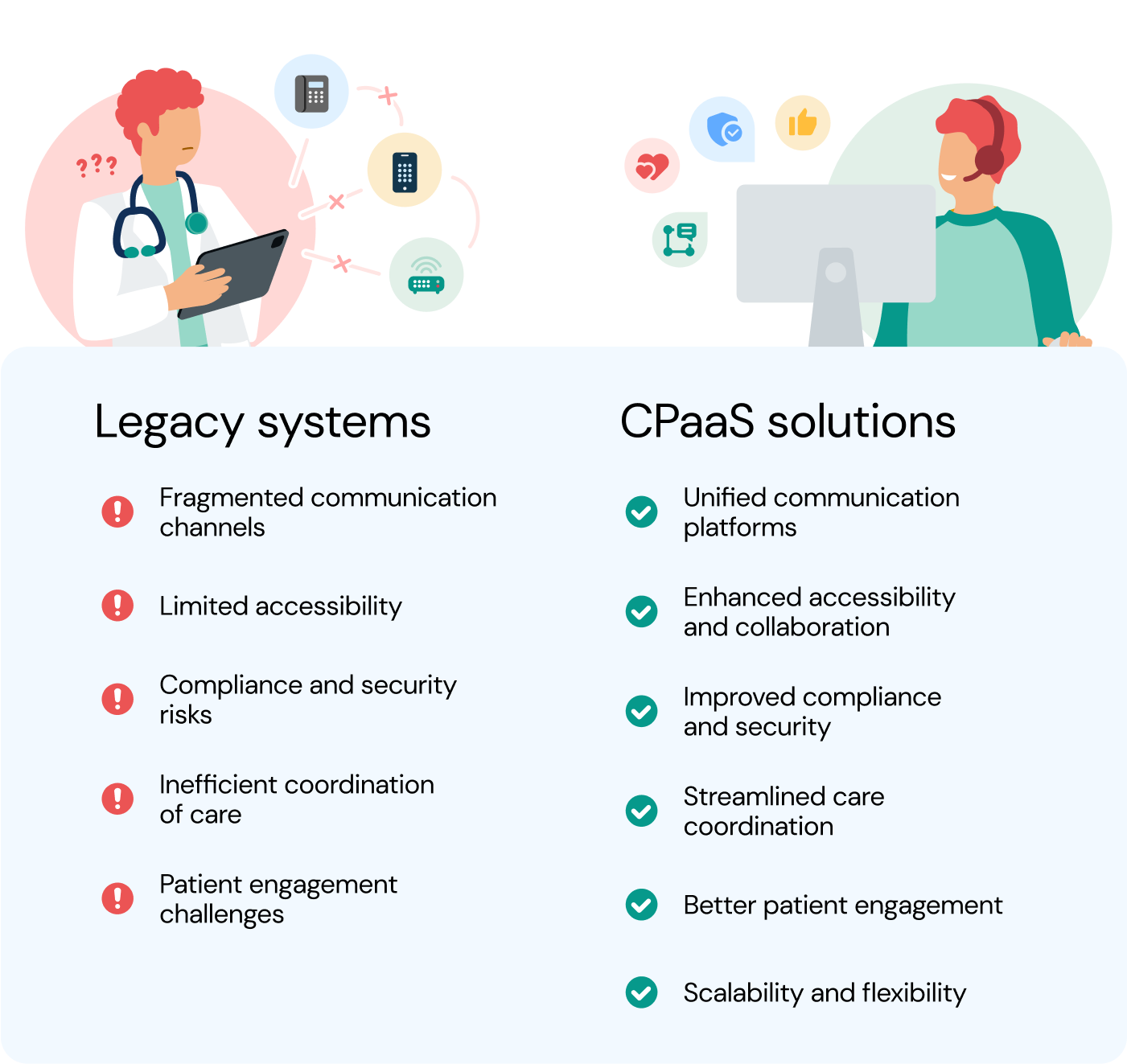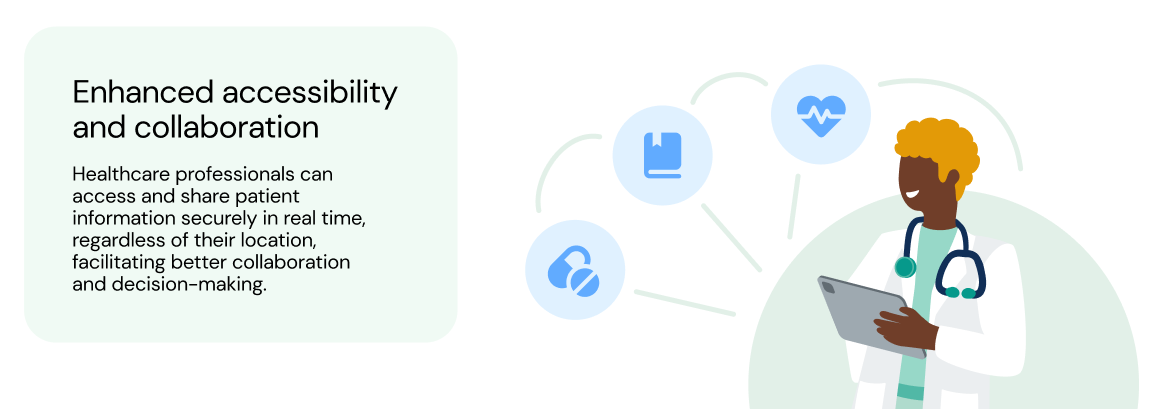Insights
Boost to the system: Advancing connected health communication

Insights

Communication is fundamental in the healthcare sector. According to the Institute for Healthcare Advancement, communicating information that patients can understand and use directly leads to better patient management, better healthcare utilization, and higher patient satisfaction. They list the 5 Cs of healthcare communication as being Caring, Customized, Clear, Concise, and Correct.
There is, however, a 6th C: Connected.
Connected health takes patient communication to another level. It’s all about using technology to safely and securely enhance the medical experience via wireless, cloud-based solutions. It covers different aspects like:
It helps connect doctors with patients or other doctors, and even lets patients chat with each other. But most of all, it’s a smart alternative to updating legacy systems still in place at healthcare centers.
And it’s all powered by Communication Platforms as a Service (CPaaS). CPaaS provides the infrastructure for healthcare providers to offer flexible and scalable telehealth, remote monitoring, and much more.
Let’s explore why connected health is the answer to updating legacy systems, how CPaaS provides the necessary backbone for it to function, and why it’s revolutionizing the way providers care for those that need it most: the patients.
Healthcare communications often struggle with functionality and adaptability issues presented by legacy systems. These systems can cause problems for medical organizations and their patients for a variety of reasons:
So why do healthcare providers often stick with their outdated systems? It boils down to a few thorny issues: Upgrades can interrupt patient care, and not everyone’s got the resources or expertise to pull off such a big change. Plus, these old systems represent significant capital investments that are tangled up with the current setup, making untangling them tricky, especially with all the compliance issues to consider.
There’s also the worry of losing custom modifications made over the years, and let’s face it, a lot of administrators just don’t like change. When a system is still doing its job without causing trouble, many think, “Why bother fixing what isn’t broken?” Tackling these hurdles requires a thoughtful approach to balance the push for new tech with continuing to deliver stable and secure healthcare.

The transition away from legacy systems isn’t just about adopting new technologies. It’s also about rethinking the way healthcare is delivered. The primary goal of providing digital health services is to improve patient outcomes and wellbeing.
Connected health communication solutions are at the forefront of this change, offering more dynamic and responsive ways to engage with patients. By embracing these technologies, healthcare providers can overcome the limitations of traditional systems and move towards a more integrated and patient-centered approach to care. These tools represent a step forward in making healthcare more accessible and efficient: Operations run smoother, data is safer, and adhering to new regulations is hassle-free.
CPaaS solutions fuel connected health, providing the infrastructure necessary to drive flexible and scalable communication solutions. Let’s take a look how:
Real-time communication technology is the backbone of connected health. Essentially, it’s bridging the gap we often see between traditional healthcare and telehealth, mainly focusing on making healthcare more accessible and convenient for everyone. Through telehealth, patients can now get medical advice, consult with doctors, and even undergo therapy sessions right from their homes using video conferencing.

Another exciting development is remote monitoring. Doctors can now keep an eye on their patients’ health in real time, thanks to technology that sends data straight to them. This means they can diagnose issues more quickly, take immediate action, and save a lot of time in the process.
We’ve outlined the benefits of a connected health solution here, but there are also certain challenges to consider:
Security, data privacy, and compliance are at the heart of connected health, patient trust, and care quality. CPaaS tools ensure that sensitive information remains protected while also meeting strict regulatory requirements.

With cyber threats becoming increasingly sophisticated, healthcare providers must ensure that every message, call, and piece of shared data is protected. Advanced encryption protocols, such as TLS and SRTP, to secure data in transit are essential deliverables from CPaaS providers. Additionally, for data at rest, providers employ tight encryption standards to ensure that patient information can’t be accessed by anyone without permission.
Data privacy in healthcare isn’t just about compliance; it’s about upholding the dignity and rights of patients. CPaaS platforms are designed to comply with data privacy laws such as HIPAA in the U.S. or the General Data Protection Regulation (GDPR) in the EU. These platforms provide healthcare organizations with the tools they need to manage consent, patient preferences, and data access rights, ensuring that patient information is shared and used appropriately, and only with the necessary consent.
Compliance with healthcare regulations is a moving target, with standards constantly evolving to address new risks and technologies. CPaaS providers must therefore be nimble, adapting to changes in regulations quickly to help healthcare organizations stay compliant. This includes not only technical measures but also ensuring that the healthcare providers’ staff is trained and aware of the compliance requirements.
Regular audits, risk assessments, and compliance certifications are part of the CPaaS package, offering healthcare providers peace of mind that they’re meeting their legal and ethical obligations. These tools often come with built-in reporting and logging capabilities, too, enabling healthcare providers to easily provide evidence of compliance should it be required by regulators.
As we look to the future, the need for healthcare providers to upgrade their communication infrastructure becomes increasingly clear. With the rise of connected health, patients are no longer passive recipients of care but active participants in their health journey. This shift requires a foundation of reliable, secure, and flexible communication tools that can support a wide range of services, from virtual consultations to remote monitoring, all while remaining compliant with regional laws and regulations. CPaaS offers all of that, but more importantly the right CPaaS provider can make the transition painless.
Sinch is here to help you through the process. The future of healthcare is digital, and at its heart is the need for strong, reliable communication infrastructure that can support this new era of connected care. Get in touch with our experts today to learn more.